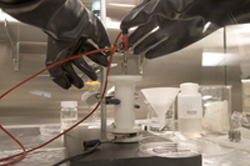Advanced Microbattery Technology Developed at UC Irvine Could Lead to Smaller, Lower Power Pacemakers, Hearing Aids
 Recently, carbon has been attracting attention as a suitable material for micro-electro-mechanical systems or MEMS, which when compared to silicon, can form complex chains, and is the basis of most polymers.
Recently, carbon has been attracting attention as a suitable material for micro-electro-mechanical systems or MEMS, which when compared to silicon, can form complex chains, and is the basis of most polymers.
The future development of battery-powered technology is focused on miniaturization, with smaller dimensions, larger storage capacity, and increased energy densities. Microbatteries, now available through new electrode materials, the development of novel micromachine battery designs, and innovative manufacturing methods, are being developed using C-MEMS technology, which addresses these new material needs and requirements.
Traditional batteries are two-dimensional (2D) and ions must travel relatively long distances from electrode to electrode, which leads to power loss, slow charging and discharging. By utilizing C-MEMS technology, Madou’s research team aims to overcome the size and energy density deficiencies of 2D microbatteries by creating designed arrangements of large numbers with high aspect ratio three-dimensional (3D) electrode elements for each electrode.
Madou’s research applies C-MEMS to the fabrication of current collectors and active electrodes. Each electrode is composed of thousands of electrode elements, and pairs of such electrodes are engineered in a novel, switchable array of microbatteries.Further, the proposed 3D microbattery design concept is specifically prepared to take advantage of the scaling relationship between interface area and overall volume. The use of 3D carbon electrode arrays enhances the surface to volume ratio of the microbattery dramatically, resulting in increased reaction surface areas and decreased ion diffusion distances.
Carbon can form different allotropes with very interesting properties (e.g. fullerenes), and also has a wide electrochemical stability window that allows its unique use as an electrode in water based solutions, where other materials would fail.
New miniature portable electronic devices, other than the microbattery that can utilize the C-MEMS technology, include cardiac pacemakers, hearing aids, smart cards, personal gas monitors, MEMS devices, embedded monitors, and remote sensors with RF capability. Along with the new material and manufacturing approach, this technology can also be used for novel miniaturized electrochemical sensors, super capacitors and fuel cells.
A company called Carbon Micro Battery Corporation (www.c-mb.com) has been created around this fundamental technology, and is currently in the process of commercializing micropower applications of C-MEMS technology.
Ultimately, C-MEMS technology gives unprecedented design freedom to INRF engineers through the use of integrated circuit (IC) fabrication techniques, arrays, switching, redundancy, repeatability, small feature size, and close integration, while fostering interdisciplinary communication with researchers from various technological backgrounds including mechanical engineering, electrical engineering, chemistry, and materials science.
For more information about Madou’s research, please visit http://mmadou.eng.uci.edu/Research/CMEMS.htm.
